 About the Netherlands CAA Reunion
About the Netherlands CAA Reunion
THE NETHERLANDS YOU DON’T KNOW #2
Story and Photos from April 23-26
CAA Co-Founder Hans van den Houten and his wife, Marian, organized the CAA reunion "The Netherlands You Don't Know #2". Here is his account of the long weekend (with photos by Jean Marc Bara; for more photos by Jean Marc, click here...we'll post additional photos in a few weeks):
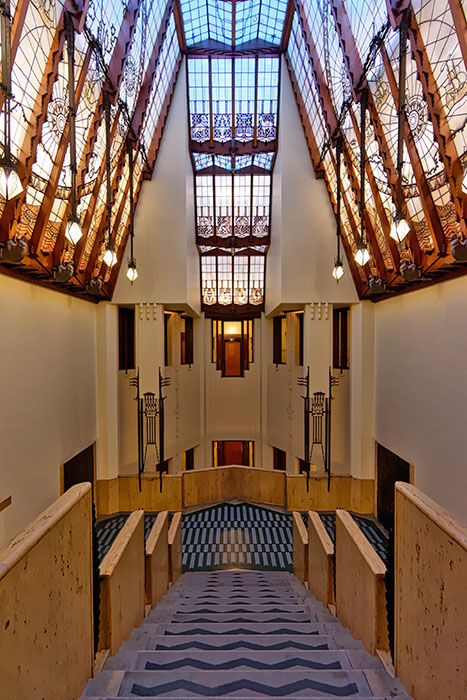 On Thursday, April 23, 2015, 32 alumni and their friends or spouses gathered on the third floor of Amsterdam’s Grand Hotel Amrâth, which occupies “het Scheepvaarthuis” or “the shipping house” on Prins Hendrikkade, once the bastion of six shipping companies that primarily operated regular voyages to the Far East. After admiring the windows and iron work that are art deco, of the Amsterdam School (see photo, left), we met briefly in the former Board Room. My wife, Marian, and I welcomed the group with a glass of Prosecco. As the weekend’s organizer, I discussed what we would do over the next three days.
On Thursday, April 23, 2015, 32 alumni and their friends or spouses gathered on the third floor of Amsterdam’s Grand Hotel Amrâth, which occupies “het Scheepvaarthuis” or “the shipping house” on Prins Hendrikkade, once the bastion of six shipping companies that primarily operated regular voyages to the Far East. After admiring the windows and iron work that are art deco, of the Amsterdam School (see photo, left), we met briefly in the former Board Room. My wife, Marian, and I welcomed the group with a glass of Prosecco. As the weekend’s organizer, I discussed what we would do over the next three days.
The weather being in our favor, we took a brisk 10-minute walk from the hotel to the “Scheepvaartmuseum” or “Maritime Museum”. Our guides, as well as Sandor and Cécile von Balluseck, who joined us just for this part of the tour, awaited us in the courtyard of this completely renovated historic arsenal. We broke into separate groups to visit the displays of maritime paintings, navigational instruments and old historic maps. Our visit could have easily been expanded by several hours, but instead eagerly boarded a touring boat, the “Multatuli” (named for a famous Dutch writer) to tour the canals and harbor of Amsterdam. Twilight was upon us, and we enjoyed a great “walking” dinner of small plates with a great variety of foods, of course, accompanied by some tasty wines. Gladly, we were able to sit very comfortably, as our increasingly aging group would have found it uncomfortable to be on our feet for the whole trip!
Gradually, the lights on the bridges of the canals were turned on. Our captain maneuvered skillfully past the glory of Amsterdam’s past, so beautifully preserved. Even if many of us had been on such tours before, the past into the present displayed in this city keeps one admiring the riches displayed along the canals and harbors. We ended this lovely tour just a short walk from the hotel and repaired to our beds for a good night’s sleep.
The 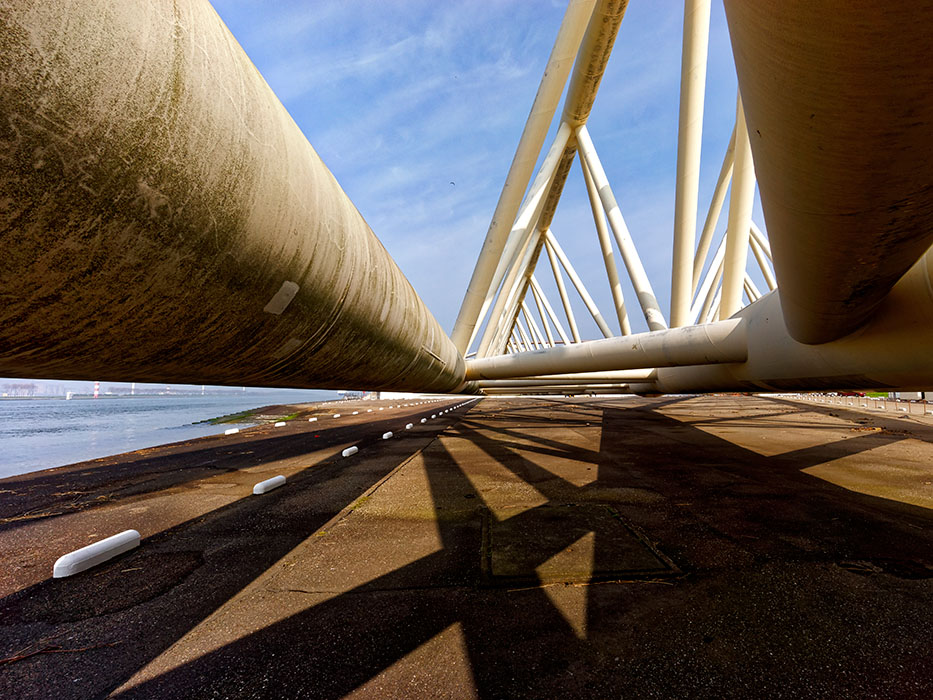 next morning was faced with an 8 am start. Luckily, traffic was less heavy than anticipated, and we arrived a bit earlier than scheduled at the “Maeslandtkering”, a storm surge barrier on the imaginary dividing line between the Nieuwe Waterweg waterway located at Hoek van Holland and the river Scheur, located along the cities of Maassluis and Vlaardingen up to the confluence of the rivers Oude Maas and Nieuwe Maas. For the next few hours, we were immersed in the wonders of water management Dutch style. This waterway barrier is a marvel of Dutch ingenuity and engineering capability. Too little space in this report to review the massive two-part barrier, which has a total length as high as the Eiffel Tower. It was completed in 1997, constructed as the last element of the Delta Plan, a Dutch law enacted after the disastrous floods of 1953, to protect the country from the ever-threatening assaults of the seas and rivers.
next morning was faced with an 8 am start. Luckily, traffic was less heavy than anticipated, and we arrived a bit earlier than scheduled at the “Maeslandtkering”, a storm surge barrier on the imaginary dividing line between the Nieuwe Waterweg waterway located at Hoek van Holland and the river Scheur, located along the cities of Maassluis and Vlaardingen up to the confluence of the rivers Oude Maas and Nieuwe Maas. For the next few hours, we were immersed in the wonders of water management Dutch style. This waterway barrier is a marvel of Dutch ingenuity and engineering capability. Too little space in this report to review the massive two-part barrier, which has a total length as high as the Eiffel Tower. It was completed in 1997, constructed as the last element of the Delta Plan, a Dutch law enacted after the disastrous floods of 1953, to protect the country from the ever-threatening assaults of the seas and rivers.
On the way to our next stop at Ouwerkerk in the province of Zeeland, we crossed by ferry the waterway mentioned above. We were able to see some huge container ships passing on the way to the North Sea, and the extensive harbors of Rotterdam. Arriving in Ouwerkerk, having consumed a Dutch “broodjes” lunch with coffee and tea on the bus, we were guided into four caissons, which were left in England after World War II and brought to the Netherlands in November 1953 to be used to close the last breach in the dyke at this town.
This all happened following the above mentioned disastrous flooding of a major portion of the Netherlands’ southwest provinces, Zeeland and Zuid Holland, during the night of February 1, 1953. The “Watersnoodmuseum” provided very good insight into the horrors of this hurricane-force storm, which took 1,836 lives, destroyed thousands of homes and drowned thousands of cattle. To further understand the impact of the hurricane, we proceeded to the town of Zierikzee, which was also completely flooded in 1953. Walking through the town made it very clear how the water had entered and utterly destroyed Zierikzee’s center. We, by contrast, had perfect weather with blue skies and clouds floating by as we walked through this very old and monumental town, viewing many of the 600 national treasures that survived in the town.
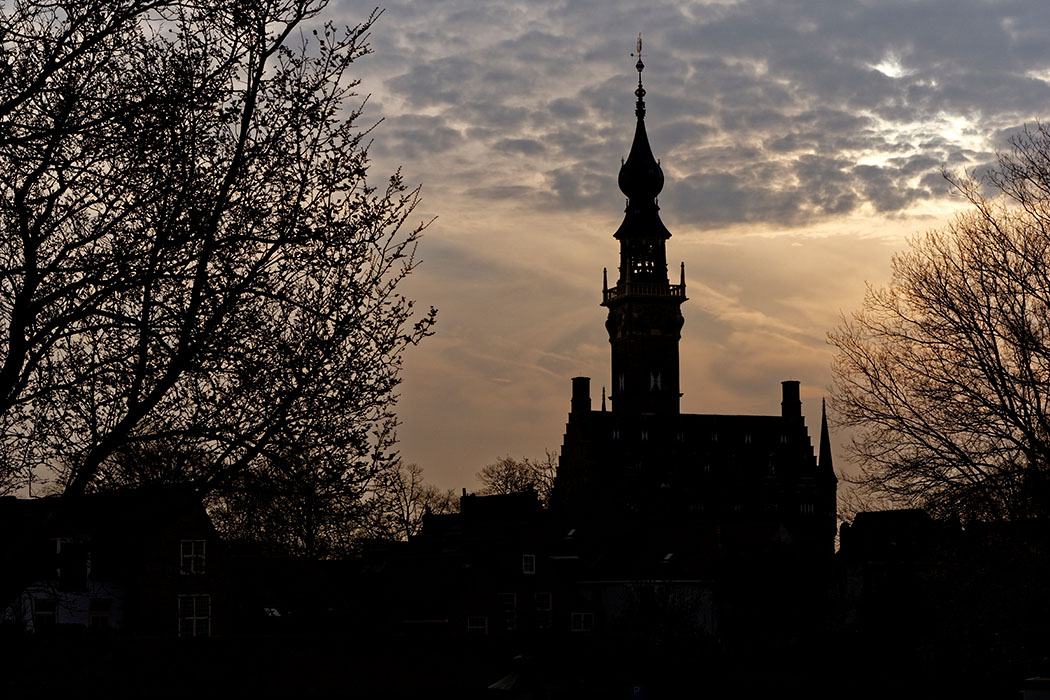 Nearly two hours later, we boarded our bus again for the Badhotel Domburg in the seaside resort town of Domburg, on the island of Walcheren. After a brief respite at the hotel, we were driven to the historic “Auberge de Campveerse Toren”, where we were welcomed with yet another sparkling glass of Prosecco to open an evening of fine food and wines. This was the same location where Prince William of Orange, William the Silent, organized a wedding feast for his third wife, Charlotte de Bourbon; in 1583, he repeated the event for his fourth wife, Louise de Coligny. Notably, Princess Grace (Kelly) also lunched at this lovely restaurant with her husband, Prince Rainier, in 1958. Since we occupied the complete dining room, no celebrities were present our night as we enjoyed bright views of the waters surrounding Veere.
Nearly two hours later, we boarded our bus again for the Badhotel Domburg in the seaside resort town of Domburg, on the island of Walcheren. After a brief respite at the hotel, we were driven to the historic “Auberge de Campveerse Toren”, where we were welcomed with yet another sparkling glass of Prosecco to open an evening of fine food and wines. This was the same location where Prince William of Orange, William the Silent, organized a wedding feast for his third wife, Charlotte de Bourbon; in 1583, he repeated the event for his fourth wife, Louise de Coligny. Notably, Princess Grace (Kelly) also lunched at this lovely restaurant with her husband, Prince Rainier, in 1958. Since we occupied the complete dining room, no celebrities were present our night as we enjoyed bright views of the waters surrounding Veere.
(Photo: Tower of the Stadhuis van Veere)
A not-too-early departure on Saturday, April 25 brought us to the town of Westkapelle, where we were guided expertly through the local “Dyke and War Museum”. We learned how the island of Walcheren was captured during WWII by the Allies, who needed to remove the Germans from this island to open and protect the Westerscheldt waterway from artillery fire; the waterway led to the harbor of Antwerp, so vital for the ongoing actions in the Ardennes at the time. The British bombarded the dykes at Westkapelle in 1944 and the island was flooded, allowing for sea landings and a defeat of the Germans. The history of this dramatic event is very well explained and displayed in this little, but very special museum.
Our next stop at the Zeeuws Museum, housed in the historic 850-year-old abbey in the town of Middelburg, the capital of Zeeland, opened more interesting historic perspectives. Our appreciation of six beautiful, priceless and fully restored, 16th century tapestries depicting the maritime battles in the waters of Zeeland during the 80-year war between the Low Countries and Spain (1568-1648) was enhanced by the expert explanations of guides.
In addition, we were shown the beautiful costumes of the Province of Zeeland. These are no longer worn in daily life, but part of the proud heritage of the people of Zeeland. We also enjoyed seeing historic earthenware, statues and jewelry dating back to the Roman times.
After a morning of cultural viewings and history, we were ready to walk a few short blocks to the “Restaurant Scherp”, where ”Jeune Restaurateur d’Europe” Mart Scherp (“Young Restauranteur of Europe”) enthralled us with a delectable lunch of a variety of fresh fish complemented with delicious wines. What a treat it was and compliments were heaved upon the young chef upon our departure, once again, for Domburg.
The afternoon was spent resting and visiting the small town, where history abounds and where a statue of the ancient Roman goddess Nehalennia is sitting on a bench facing the sea, still protecting the safe passage through the Westerscheldt and North Sea.
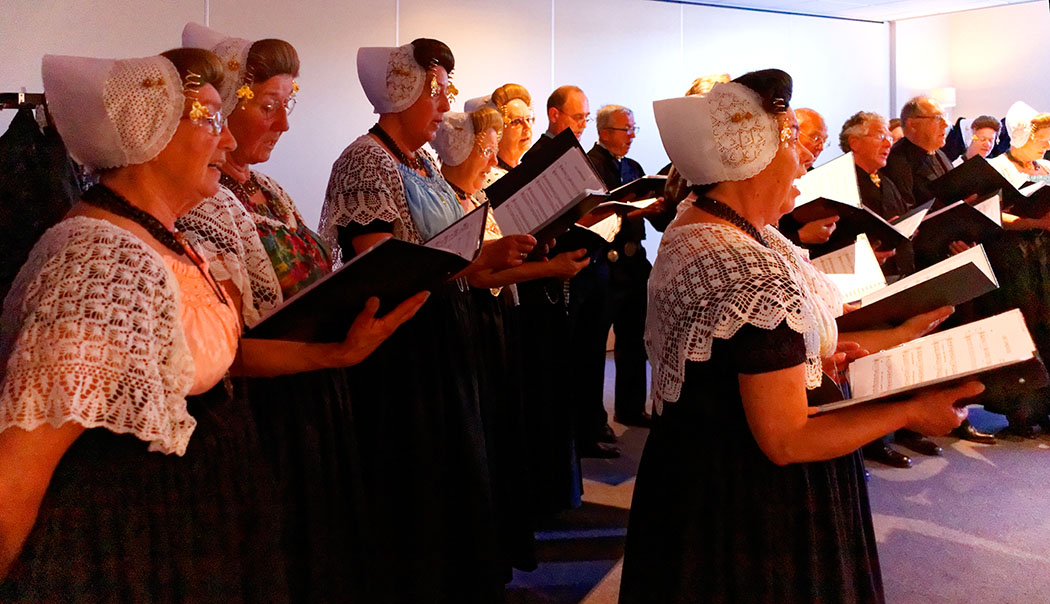 Another evening of relaxation was upon us with an overture of cocktails and snacks in the library lounge of the hotel. Suddenly, the walls of the library were opened and here appeared some 30 Zeelanders dressed in traditional costumes, serenading us for the next half hour with shanties and other songs in a variety of languages. This was such a wonderful opportunity to see the dresses of the ladies with their caps and jewelry enhancing their traditional garb and the men in their solemn suits and caps. This treat readied us for another dining experience, in the hotel. We did not suffer from a few more libations again in the library lounge before we all retired to our rooms.
Another evening of relaxation was upon us with an overture of cocktails and snacks in the library lounge of the hotel. Suddenly, the walls of the library were opened and here appeared some 30 Zeelanders dressed in traditional costumes, serenading us for the next half hour with shanties and other songs in a variety of languages. This was such a wonderful opportunity to see the dresses of the ladies with their caps and jewelry enhancing their traditional garb and the men in their solemn suits and caps. This treat readied us for another dining experience, in the hotel. We did not suffer from a few more libations again in the library lounge before we all retired to our rooms.
Sunday, April 26, our final day of “The Netherlands You Don’t Know #2”! The day was a bit gloomy, but suitable for a visit to the major construction of the Delta Plan, the water barrier across the Oosterschelde. This nine-kilometer long dam has four kilometers of sluice-like doors, which allow for the water to move in and out of the estuary and protect the salt water marine life behind the dam.
It was a really instructive visit, where we clambered up and down and through the barrier construction, fascinating to witness the flow of the water through the sluices at low tide. This part of the Delta Plan is a particularly amazing feat. It was inaugurated by then Queen Beatrix on October 4, 1986 with the historic words: "De stormvloedkering is gesloten. De Deltawerken zijn voltooid. Zeeland is veilig." (The flood barrier is closed. The Delta Works are completed. Zeeland is safe.)
Our next visit was in Nederwaard in the province of Zuid Holland, just east of Rotterdam. Another box lunch on board of the bus fortified us prior to viewing a system of 19 windmills constructed in 1740 to allow for the removal of the water from the various “polders” (reclaimed land). We took a boat to view the windmills from the water and ended at one of the mills. We had a closer look at the interior and workings of the mill, which housed the miller and his family, and Jean Marc Bara took us to a spot on a dyke to have our group picture taken. (See above)
Our fi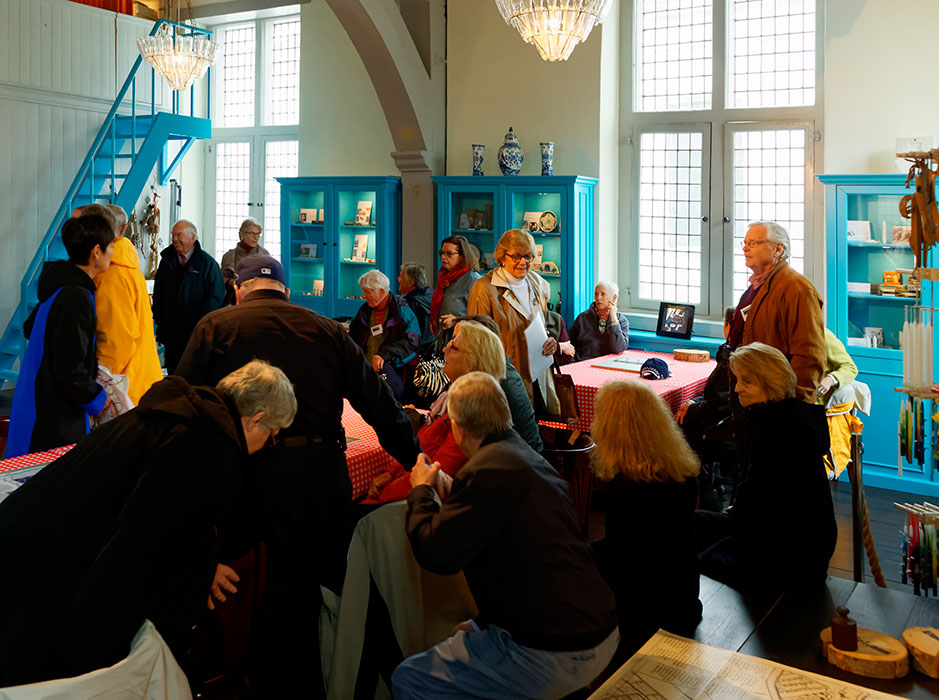 nal stop was in the old city of Gouda, known around the world for its famous cheese and lesser known for its production of clay pipes and candles. The Goudse Waag, an historic building dating from 1668, was used until the early part of the 20th century to weigh the cheese brought to market by local farmers. It is now a museum, where the art of cheese making is explained, together with the traditions of clay pipe manufacturing. We had a nice walk through the old town back to our bus, ready to sit back and have our terrific driver, Ben Hammink, take us to our final meal on this trip. This brought us to the town of Uithoorn, where we entered the historic restaurant “Het Rechthuis aan de Amstel”. This restaurant once saw the reconciliation effort by Governor William III of the admirals Michiel de Ruyter and Cornelis Tromp, who had fallen out with each other. No better place, right on the river Amstel, then to conclude our historic and technically loaded program. The female owners and their chef turned out a delightful meal with wines and service to match.
nal stop was in the old city of Gouda, known around the world for its famous cheese and lesser known for its production of clay pipes and candles. The Goudse Waag, an historic building dating from 1668, was used until the early part of the 20th century to weigh the cheese brought to market by local farmers. It is now a museum, where the art of cheese making is explained, together with the traditions of clay pipe manufacturing. We had a nice walk through the old town back to our bus, ready to sit back and have our terrific driver, Ben Hammink, take us to our final meal on this trip. This brought us to the town of Uithoorn, where we entered the historic restaurant “Het Rechthuis aan de Amstel”. This restaurant once saw the reconciliation effort by Governor William III of the admirals Michiel de Ruyter and Cornelis Tromp, who had fallen out with each other. No better place, right on the river Amstel, then to conclude our historic and technically loaded program. The female owners and their chef turned out a delightful meal with wines and service to match.
The ambiance reflected the whole of our three days: a gathering of like-minded CAA members and their spouses or friends, in the thrall of technologically unparalleled water management, powerful museums and historic towns. Above all, the great camaraderie amongst members of the Chase Alumni Association was fueling our days in the Netherlands, where we are now a bit more knowledgeable about “The Netherlands We Did Not Know!”
The following CAA members with friends and/or spouses took part of our journey:
James Adamson & Vivian Lind;
Charlotte and David Ball;
Anne Bush;
Jean Marc and Marianne Bara;
Tom and Nancy Farrell;
Jim and Mary Fleming;
Becky Ford and Jim Johnson;
Toni Geyelin;
Paul Heller and Ruth Acker;
Stephen and Betsy Hunter;
Ken and Ann Jablon;
Maria and Gerhard Lippburger;
Tom Lynch;
Jean Claude and Myriam Schaeffer;
Hans and Marian van den Houten;
John and Denise Ward;
Jeanne Warner, and
David & Beryl Willmot
Thank Yous...
* * *
From Tom Lynch:
And here’s our final word:
As you know, Beryl and I stayed on for a few days in Amsterdam, and got home late last night. Koningsdag is an unusual sight, to say the least, and my memory is that it is a party from the top of Damrak to the bottom of Rokin ( hat being almost as far as I could walk). We still discuss how many fell into the canals, given the number of boats, loaded to the gunwhales with people, booze and food.!
But now, we must thank you and Marian for all the hard work you both put in to organising and shepherding all of us around. We both thought it was a super trip, and most informative. It was pretty obvious to us the mistakes made by the UK Government, who thought they could save money by ceasing to dredge rivers, and then wonder why flood plains developed. The restaurants chosen for meals were excellent, and I suspect that we ate and drank too much.However, it was thoroughly enjoyable.
Thank you once again. I’m sure our paths will cross again in the future.
Kindest regards to you both,
